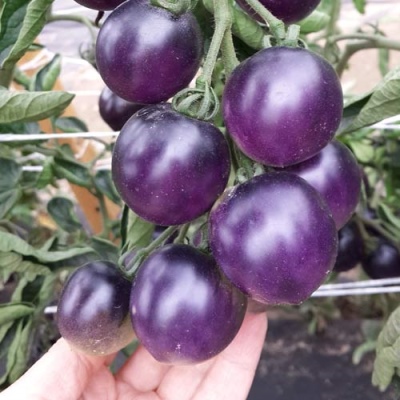
- Category: hybrid
- Growth type: indeterminate
- Appointment: fresh consumption, for pickling and preserving
- Ripening period: ultra early
- Ripening time, days: 80
- Growing conditions: for open ground, for greenhouses
- Bush height, cm: up to 150
- Ripe fruit color: blue and blue
- Fruit shape: rounded, aligned
- Yield: up to 6 kg per bush
Tomato Blue bunch is a hybrid with a completely unique color of fruits, collected in elegant large clusters. It was brought out by the domestic company "Russian Garden" from the city of Shchelkovo. It is highly valued for its spectacular appearance, pleasant taste of the fruits, but requires careful attention to cultivation, strict adherence to agricultural technology.
Description of the variety
Bushes of the indeterminate hybrid Blue bunch grow up to 150 cm in height. The plant has a low leafiness. The shoots of the bush are strong, strong, straight. The leaves are rather large, drooping, slightly wrinkled. Fruit-bearing clusters include 15–20 tomatoes.
The main qualities of the fruit
Ripe tomatoes are blue and blue, small in size. The average weight does not exceed 20-25 g. The shape of each fruit is round and calibrated. The pulp is juicy, red.
Taste characteristics
Tomatoes produce very sweet fruits that are pleasant when eaten fresh. The taste has light fruity notes, a slight sourness remains even at full maturity.
Ripening and fruiting
Ultra early hybrid. Ripens in an average of 80 days. The crop is harvested in July and August.
Yield
Up to 6 kg of fruits are harvested from the bush.
The timing of planting seedlings and planting in the ground
Sowing begins in March, starting from 2-3 decades. You can throw seeds directly into the soil, as well as form young shoots in containers, peat pots. With the appearance of 2 sheets, a mandatory pick is made. Seedlings are transferred to the ground or greenhouses after 1.5 months.

Growing tomato seedlings is an extremely important process, because it largely depends on whether the gardener can harvest at all. All aspects must be taken into account, from seedbed preparation to planting in the ground.
Landing scheme
Plants are placed at a distance of 70 × 40 cm.

Growing and caring
The tomato is suitable for planting in greenhouses and outdoors. Needs a pegged garter. A suitable soil type is light, fertile, with neutral acidity. Bushes with 8-9 leaves are ready for transplantation. They are formed into 1–2 trunks, removing the yellowed growth at the bottom.
Agrotechnical measures for the Blue bunch hybrid should be quite active. During the growing season, tomato bushes require 3-4 full dressings, mainly potassium-phosphorus. Organic matter is given only at the initial stage of growth, to stimulate the development of green mass.




A plant needs different micronutrients at each stage of growth. All fertilizers can be divided into two groups: mineral and organic. Folk remedies are often used: iodine, yeast, bird droppings, eggshells.
It is important to observe the rate and period of feeding. This also applies to folk remedies and organic fertilizers.
Disease and pest resistance
The hybrid is well protected against most common tomato diseases. It is not affected by late blight due to early planting and maturation. From insect pests to plants, a standard insecticidal treatment will suffice. Folk remedies and complex biological products are suitable. Preventive soil treatment with Bordeaux liquid or Fitosporin before planting plants will not be superfluous.


Resistant to adverse weather conditions
The tomato successfully tolerates temperature extremes, short-term periods of drought. In general, it is well adapted to difficult weather conditions.
Growing regions
Indoor planting is recommended for this hybrid only in cold regions: Siberia, the Urals, the Arkhangelsk region and Karelia. Without greenhouses, tomatoes can be placed outdoors in most regions with a fairly long warm period. In the south, they are sown directly into the soil, without the stage of growing seedlings.
Review overview
Buyers leave rather controversial, but generally positive reviews about the Blue Bunch tomatoes. It is noted that the seeds have serious germination problems. Only 2–3 out of 10 can germinate, which, given the high initial cost of planting material, does not look very impressive. Not everyone likes the tallness of the tomato - without pinching the top, it will continue to grow the stem height up to 2 meters or more.
When harvesting, summer residents note possible problems with recognizing the ripeness of blue tomatoes. It is not visually possible to understand how ripe they are. But in green tomatoes, the pulp has a plum hue, it tastes more like a fruit than a vegetable. Cocktail sizes allow the use of berries for preservation, in salads, fruits also show themselves well, giving them unusual flavoring shades.
Among other disadvantages of the hybrid are low keeping quality, poor transportability of tomatoes. Summer residents also mention that this is a hybrid of the first generation, so it will not work to get the same tomatoes from the harvested seeds again.Regarding the color of the skin, it is noted that in greenhouses it turns out to be paler, rather blue. The taste of the fruit obtained in the open field is rated higher than that obtained in the closed field.

























































































